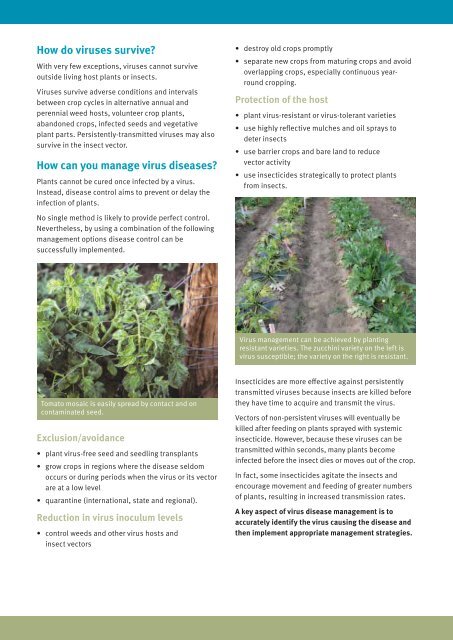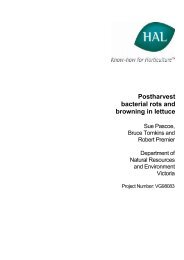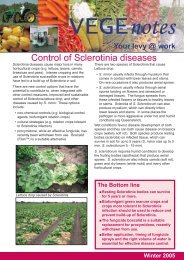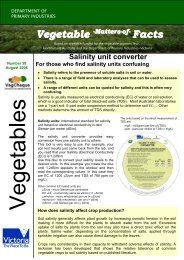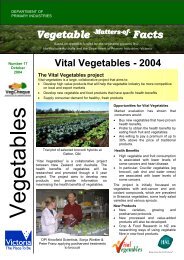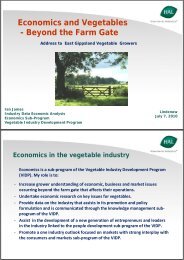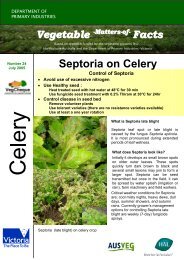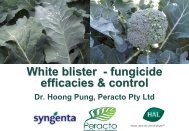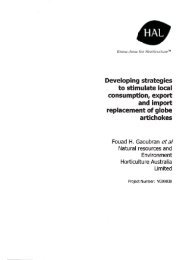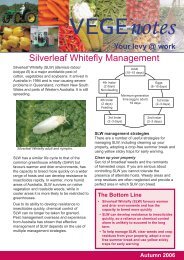Viruses in vegetable crops in Australia
Viruses in vegetable crops in Australia
Viruses in vegetable crops in Australia
Create successful ePaper yourself
Turn your PDF publications into a flip-book with our unique Google optimized e-Paper software.
How do viruses survive?With very few exceptions, viruses cannot surviveoutside liv<strong>in</strong>g host plants or <strong>in</strong>sects.<strong>Viruses</strong> survive adverse conditions and <strong>in</strong>tervalsbetween crop cycles <strong>in</strong> alternative annual andperennial weed hosts, volunteer crop plants,abandoned <strong>crops</strong>, <strong>in</strong>fected seeds and vegetativeplant parts. Persistently-transmitted viruses may alsosurvive <strong>in</strong> the <strong>in</strong>sect vector.How can you manage virus diseases?Plants cannot be cured once <strong>in</strong>fected by a virus.Instead, disease control aims to prevent or delay the<strong>in</strong>fection of plants. destroy old <strong>crops</strong> promptly separate new <strong>crops</strong> from matur<strong>in</strong>g <strong>crops</strong> and avoidoverlapp<strong>in</strong>g <strong>crops</strong>, especially cont<strong>in</strong>uous yearroundcropp<strong>in</strong>g.Protection of the host plant virus-resistant or virus-tolerant varieties use highly reflective mulches and oil sprays todeter <strong>in</strong>sects use barrier <strong>crops</strong> and bare land to reducevector activity use <strong>in</strong>secticides strategically to protect plantsfrom <strong>in</strong>sects.No s<strong>in</strong>gle method is likely to provide perfect control.Nevertheless, by us<strong>in</strong>g a comb<strong>in</strong>ation of the follow<strong>in</strong>gmanagement options disease control can besuccessfully implemented.Virus management can be achieved by plant<strong>in</strong>gresistant varieties. The zucch<strong>in</strong>i variety on the left isvirus susceptible; the variety on the right is resistant.Tomato mosaic is easily spread by contact and oncontam<strong>in</strong>ated seed.Exclusion/avoidance plant virus-free seed and seedl<strong>in</strong>g transplants grow <strong>crops</strong> <strong>in</strong> regions where the disease seldomoccurs or dur<strong>in</strong>g periods when the virus or its vectorare at a low level quarant<strong>in</strong>e (<strong>in</strong>ternational, state and regional).Reduction <strong>in</strong> virus <strong>in</strong>oculum levels control weeds and other virus hosts and<strong>in</strong>sect vectorsInsecticides are more effective aga<strong>in</strong>st persistentlytransmitted viruses because <strong>in</strong>sects are killed beforethey have time to acquire and transmit the virus.Vectors of non-persistent viruses will eventually bekilled after feed<strong>in</strong>g on plants sprayed with systemic<strong>in</strong>secticide. However, because these viruses can betransmitted with<strong>in</strong> seconds, many plants become<strong>in</strong>fected before the <strong>in</strong>sect dies or moves out of the crop.In fact, some <strong>in</strong>secticides agitate the <strong>in</strong>sects andencourage movement and feed<strong>in</strong>g of greater numbersof plants, result<strong>in</strong>g <strong>in</strong> <strong>in</strong>creased transmission rates.A key aspect of virus disease management is toaccurately identify the virus caus<strong>in</strong>g the disease andthen implement appropriate management strategies.


